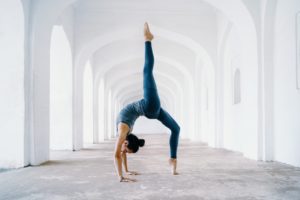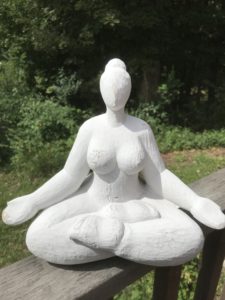Yoga is a Feminist Issue

Image from unsplash.
Modern American yoga primarily belongs to women. Not so for earlier yoga or for the yoga of India or the yoga of long ago—the details of which are mostly lost to us. It is a feminist issue then, not simply because it is made of so many women, but because the modern practice is obsessed with the female body. And the female body is a feminist issue because until we stop treating the woman AS a body, there will be no human liberation.
Yoga comes out of and exists in a tradition, that is, a place, time and culture. It troubles me whenever I hear people say, we must go back to TRADITION. As a minister, let me tell you something about tradition. The church uses exclusively male pronouns for God. Is that because God is a male? God has no gender. Is that because HE is right or correct? Certainly not. It’s because many wrongly assume that anything that has tradition behind it is right.
Let’s consider the tradition of whipping children, at home and in classes. Or perhaps we could take the tradition of drinking. Many of you come from a long line of drinkers. That is certainly a family tradition. The fact that something, or anything, is done over and over again, does not make it right or useful.
I am not primarily interested in tradition. I am interested in liberation. Anything good, useful, helpful or empowering from tradition will continue on its own. We don’t need to run in and save it, as if from a burning building. Some things ought to burn to ashes—among them oppression, prejudice, misogyny, racism, and all of the abuses related to those evils.
Modern practitioners of yoga have done an excellent job of getting rid of tradition—sometimes losing good in it, unfortunately. Yet no one practicing does not also come with their own tradition, their own cultural lens, their own created conceptions.

Yoga practice on the rock while the baby nurses.
Why else do we have all the depictions of white, skinny, yoga-pant clad women? What do their bodies say? What do they long to convey with the images of them in practice?
Yoga, as posture practice (and there are many other kinds of yoga, for example Bhakti, or devotional), is a place of deep body work. The body is central. It is the tool for enlightenment. In it we use the body and go deeply into the experience and sensations of the body in order to ultimately come back into a place of balance as integrated people who are much more than our bodies but not separate from them.
We are a body obsessed culture. With social media, it is perhaps even a fetish. I have teenagers. I get to see the selfies. But it would be nice, wouldn’t it, if yoga, as a path of liberation, had something different to say, something revelatory and powerful to add to the conversation?
Modern posture yoga has contributed to criticism of the female body, expectations of the female body, standards for the body, and eroticism of the body that are limited by our cultural moment. What is beautiful? What is good? What is healthy? A patriarchal, male-dominated practice such as yoga—and this is historically true—must be reinvented. And so far, we have seen this reinvention. But sadly, it has not been willing to liberate itself.
What do I mean? On both a personal and collective level, many have not been able to liberate themselves, despite years of practice and training, in relationship to their bodies. I don’t want to say that people have not liberated themselves in other ways. I am confident they have. Yoga posture practice has given so many of us new peace and joy and connection to Source. But has it given us a new connection to our bodies?
If it has not, it must. We are not liberated as minds only. We cannot say, “I am a feminist,” and then proceed to depict ourselves as a body to be seen through the male gaze—a gaze women have adopted subconsciously. Are we a collection of body parts doing yoga? Do we need to “look good” doing it? If we are doing good and feeling good, what do we actually and accurately look like on the outside?
The best of yoga cannot be seen with the eye. The true pose will never be captured by a phone or camera. It is an experience, an inward moving experience. And no person, male or female, is free in yoga until they are free from the tyranny of body image. According to Oxford languages, body image is defined as: the subjective picture or mental image of one’s own body.
Subjective. Yoga MUST be teaching us that we don’t see clearly MOST of the time. Body image is an illusory thing. A fallacy. A mirage. A non-thing. Without substance or heft. But your body, it is something. It is tangible. Real. Feelable and solid.
For human liberation, we must overcome not just our own limited sight, but that of the culture and time that we live in. To love the beautiful body we possess is to rightly understand namaste. It is to know more truly and clearly who we are and who is the other that we greet. Feminism concerns itself with this kind of human liberation. Liberating women liberates men. It is that simply. Yoga longs to free us up for the important work. We are tied down instead, perseverating over the size of our butts, the wrinkles of our face, the acreage of our thighs. This LIMITS us. This keeps us asleep.
Freedom is the felt, lived and enacted experience of Good or God expression through us in limitless ways. Freedom is to climb out of the small box of “tradition” and what it says—women should be thin, or quiet or pretty or flexible or kind—into the great expanse of the infinite. You are NOT what you look like in an image. But for a moment in time, to feel yourself awake and embodied, is to have the smallest glimmer of who we truly are. This seeing is only ever done with the eyes of the heart.